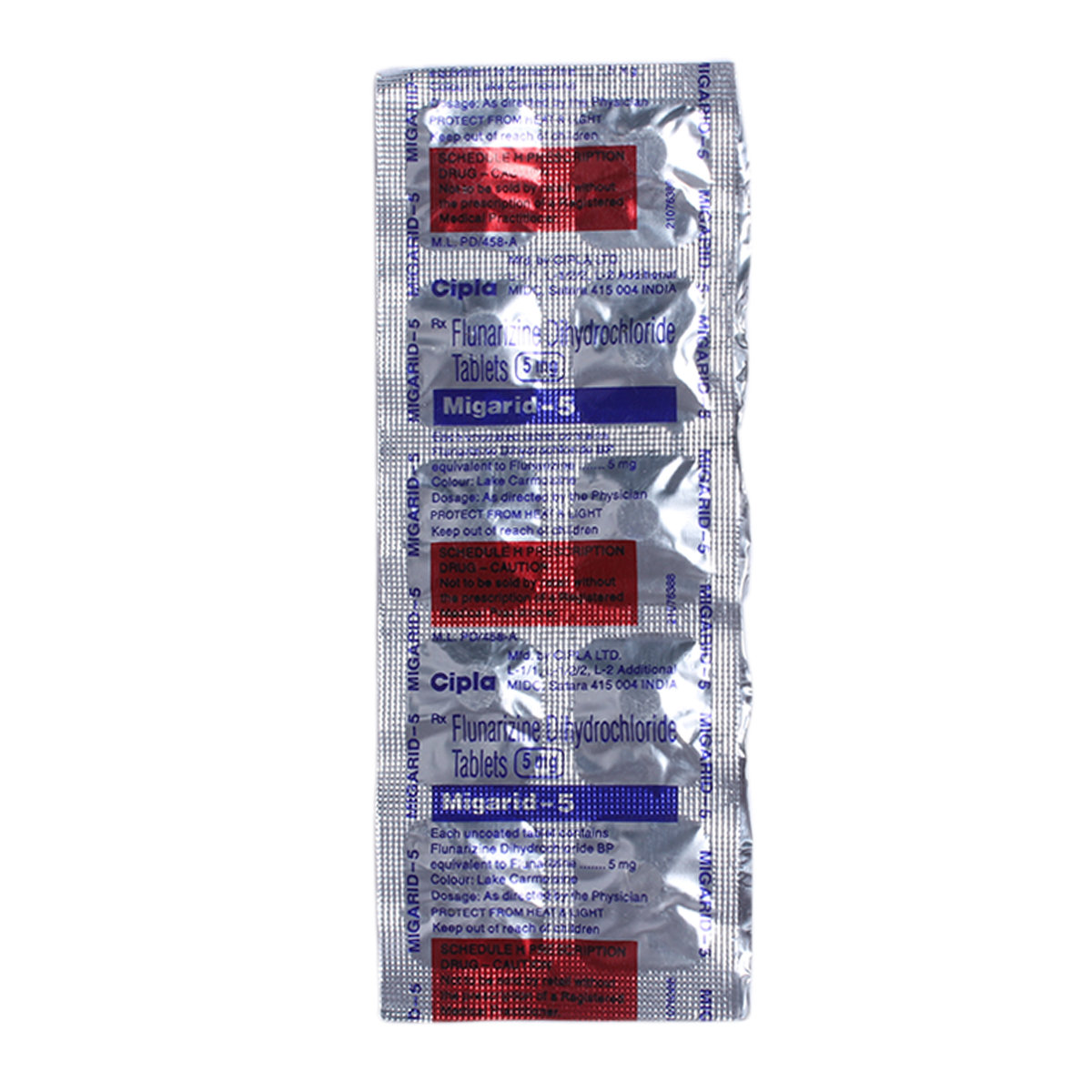Flunarin 5 Tablet





MRP ₹25.5
(Inclusive of all Taxes)
₹3.8 Cashback (15%)
know your delivery time
Provide Delivery Location
Composition :
Manufacturer/Marketer :
Consume Type :
Expires on or after :
Return Policy :
NPPA :

Secure Payment

Trusted by 8 Crore Indians

Genuine Products
Therapeutic Class
Country of origin
Manufacturer/Marketer address
Disclaimer
Alcohol
Safe if prescribed
Alcohol may increase the risk of tiredness and drowsiness with Flunarin 5 Tablet . If you do feel tired or drowsy whilst taking Flunarin 5 Tablet , avoid alcoholic drinks.
Pregnancy
Consult your doctor
Flunarin 5 Tablet is not recommended during pregnancy. Consult your doctor before taking Flunarin 5 Tablet .
Breast Feeding
Consult your doctor
Flunarin 5 Tablet is not recommended during breastfeeding. Consult your doctor before taking Flunarin 5 Tablet .
Driving
Safe if prescribed
Taking Flunarin 5 Tablet may cause dizziness, drowsiness, tiredness, or any visual disturbances; you must not drive or use machinery.
Liver
Consult your doctor
Flunarin 5 Tablet to be taken with caution, especially if you have a history of liver diseases/conditions. The dose may have to be adjusted by your doctor.
Kidney
Consult your doctor
Flunarin 5 Tablet to be taken with caution, especially if you have a history of kidney diseases/conditions. The dose may have to be adjusted by your doctor.
Children
Safe if prescribed
Generally, Flunarin 5 Tablet is not recommended for children below 12 years with or without a doctor's consent. In case it has to be given, then the dose has to be adjusted and recommended by a child specialist only.
Product Substitutes
About Flunarin 5 Tablet
Flunarin 5 Tablet belongs to the class of medication called calcium channel blockers which contains Flunarizine, used to treat migraine, dizziness, and vertigo (unable to stand properly). Migraine is a central nervous system or neurological condition, which can cause multiple symptoms. Generally, severe headache is a characteristic symptom of migraine.
Flunarin 5 Tablet contains Flunarizine, prescribed for the improvement of blood flow and in the treatment of peripheral vascular diseases. Flunarin 5 Tablet improves blood flow and dilates blood vessels in the brain thereby preventing dilation of blood vessels, loss of tune and headaches caused due to migraine.
Take Flunarin 5 Tablet as prescribed. Your doctor will recommend you how often you take Flunarin 5 Tablet based on your medical condition. Do not abruptly stop taking Flunarin 5 Tablet or skip any doses. It is advised to finish the full course of treatment. The doctor will advise you if dose adjustment is required depending upon your medical condition. In some cases, Flunarin 5 Tablet may cause fatigue, constipation, nausea, runny nose, and insomnia (difficulty sleeping). Most of these side effects of Flunarin 5 Tablet do not require medical attention and gradually resolve over time.
Do not take Flunarin 5 Tablet for an acute attack of migraine as it does not prevents it. Flunarin 5 Tablet may cause weight gain in some cases, so avoid eating junk and eat a healthy, balanced diet, including home-cooked food. If you plan to get pregnant, are pregnant or breastfeeding, please inform your doctor before taking Flunarin 5 Tablet . Flunarin 5 Tablet is also known to cause mood changes. Therefore, try to spend quality time with your family and regularly monitor your behavior.
Uses of Flunarin 5 Tablet
Medicinal Benefits Mweb
Key Benefits
Flunarin 5 Tablet is effective in reducing the attack of migraine. Still, it is specifically useful in migraine with disabling and severe neurological symptoms (like in case of migraine with aura or one-sided weakness) accompanied by dizziness or vertigo.
Directions for Use
Side Effects of Flunarin 5 Tablet
- Low mood
- Weight gain
- Fatigue (tiredness)
- Drowsiness
Drug Warnings
Do not take Flunarin 5 Tablet if you are hypersensitive to flunarizine or any of its ingredients, If you have or ever had depression, Parkinson's disease, liver damage, or kidney disease, inform your doctor before starting Flunarin 5 Tablet . Also, take a meal at the same time of day, preferably during the night. Flunarin 5 Tablet is known to cause weight gain, so avoid chocolates, junk food, cheese, processed food, alcohol, smoking, and instead eat a healthy diet and do regular exercise. Avoid loud music, extreme temperatures, bright lights, noisy places as it can increase headache. Flunarin 5 Tablet interacts with sleeping pills, anti-anxiety medicines, muscle relaxants, tranquilizers, anti-seizure, or medicines to control fits. So, if you are using these medicines, let your doctor know about them.
Drug-Drug Interactions
Drug-Drug Interactions
Login/Sign Up
Drug-Food Interactions
Drug-Food Interactions
Login/Sign Up
Drug-Diseases Interactions
Drug-Diseases Interactions
Login/Sign Up
Drug-Drug Interactions Checker List
- ALPRAZOLAM
- LORAZEPAM
- CLOBAZAM
- DIAZEPAM
- MIDAZOLAM
- BACLOFEN
Habit Forming
Special Advise
Do not use this Flunarin 5 Tablet if your suffering current depressive illness or with a history of recurrent depression, let your doctor know about it.
Diet & Lifestyle Advise
- Avoid chocolates, junk food, cheese, processed food, alcohol, smoking, and instead eat a healthy diet and do regular exercise to avoid weight gain caused due to Flunarin 5 Tablet .
- Avoid loud music, extreme temperatures, bright lights, noisy places as it can increase headache.
- Find humor in your daily life. Try to watch a comedy show to help relieve stress.
- You can try increasing your mindfulness by including yoga, meditation, mindfulness-based cognitive therapy, and mindfulness-based stress reduction.
- Drink enough water to stay hydrated, and limit or avoid alcohol and caffeine to relieve headaches.
- Include a diet rich in whole grains, vegetables, and fruits. This is a healthier option than eating a lot of simple carbohydrates found in processed foods.
- You can include antioxidants in your daily diet like ashwagandha, omega-3 fatty acids, green tea, and lemon balm.
- Try to spend time with your friends and family. Having a strong social network may help you lower your risk of anxiety.
All Substitutes & Brand Comparisons
RX
Migarid 5 Tablet 10's
Cipla Ltd
₹22
(₹1.99 per unit)
13% CHEAPERRX
Fluner 5 Tablet 10's
Geno Pharmaceuticals Pvt Ltd
₹24.5
(₹2.21 per unit)
3% CHEAPERRX
Out of StockFlunarex-5 Tablet 10's
Sherings Pharmaceuticals
₹24.5
(₹2.21 per unit)
3% CHEAPER

Have a query?
Buy best C.n.s Drugs products by
Intas Pharmaceuticals Ltd
Sun Pharmaceutical Industries Ltd
Torrent Pharmaceuticals Ltd
Alkem Laboratories Ltd
Abbott India Ltd
Cipla Ltd
Alteus Biogenics Pvt Ltd
Micro Labs Ltd
Lupin Ltd
Ipca Laboratories Ltd
D D Pharmaceuticals Pvt Ltd
Icon Life Sciences
Mankind Pharma Pvt Ltd
Tripada Healthcare Pvt Ltd
Arinna Lifesciences Ltd
Linux Laboratories Pvt Ltd
East West Pharma India Pvt Ltd
La Renon Healthcare Pvt Ltd
Talent India Pvt Ltd
Tas Med India Pvt Ltd
Zydus Healthcare Ltd
Cnx Health Care Pvt Ltd
Eris Life Sciences Ltd
Leeford Healthcare Ltd
Emcure Pharmaceuticals Ltd
Macleods Pharmaceuticals Ltd
Sigmund Promedica
Aristo Pharmaceuticals Pvt Ltd
Dr Reddy's Laboratories Ltd
Troikaa Pharmaceuticals Ltd
Consern Pharma Ltd
Zydus Cadila
Shine Pharmaceuticals Ltd
Wockhardt Ltd
Ardent Life Sciences Pvt Ltd
Crescent Formulations Pvt Ltd
Theo Pharma Pvt Ltd
Reliance Formulation Pvt Ltd
Ikon Pharmaceuticals Pvt Ltd
Propel Healthcare
Neon Laboratories Ltd
Jagsam Pharma
Msn Laboratories Pvt Ltd
Morepen Laboratories Ltd
Pulse Pharmaceuticals
Sanofi India Ltd
Med Manor Organics Pvt Ltd
Hetero Healthcare Pvt Ltd
Novartis India Ltd
Crescent Therapeutics Ltd
Elder Pharmaceuticals Ltd
Solvate Laboratories Pvt Ltd
Akumentis Healthcare Ltd
Mova Pharmaceutical Pvt Ltd
Psyco Remedies Ltd
Tripada Lifecare Pvt Ltd
Ajanta Pharma Ltd
Cyrus Remedies Pvt Ltd
Medishri Healthcare Pvt Ltd
Cadila Healthcare Ltd
Glenmark Pharmaceuticals Ltd
Matteo Health Care Pvt Ltd
Hbc Life Sciences Pvt Ltd
Lyf Healthcare
Matias Healthcare Pvt Ltd
Mesmer Pharmaceuticals
Alembic Pharmaceuticals Ltd
Capital Pharma
Crescent Pharmaceuticals
Medopharm Pvt Ltd
Alniche Life Sciences Pvt Ltd
Kivi Labs Ltd
Talin Remedies Pvt Ltd
USV Pvt Ltd
Quince Lifesciences Pvt Ltd
Solis Pharmaceuticals
Infivis Life Care
Zuventus Healthcare Ltd
Cadila Pharmaceuticals Ltd
Pfizer Ltd
Wallace Pharmaceuticals Pvt Ltd
A N Pharmacia Laboratories Pvt Ltd
Blue Cross Laboratories Pvt Ltd
Jenburkt Pharmaceuticals Ltd
Lia Life Sciences Pvt Ltd
Mano Pharma
Medley Pharmaceuticals Ltd
Primus Remedies Pvt Ltd
FDC Ltd
Maneesh Pharmaceuticals Ltd
Apex Laboratories Pvt Ltd
Gagnant Healthcare Pvt Ltd
Ozone Pharmaceuticals Ltd
RPG Life Sciences Ltd
Strides Shasun Ltd
Unichem International
GlaxoSmithKline Pharmaceuticals Ltd
Kuresys Labs Pvt Ltd
LA Pharma
Trion Pharma India Llp











